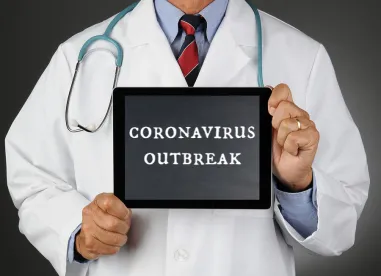On April 22, 2020, the US Department of Health and Human Services (HHS) announced the process and priority for the next release from the Public Health and Social Services Emergency Fund (the Fund) with an additional $40.4 billion to be distributed to providers over the next several weeks. HHS also announced a process for providers to seek reimbursement for treating uninsured patients.
The Coronavirus Aid, Relief, and Economic Security (CARES) Act established the Fund to provide financial relief to healthcare providers affected by the Coronavirus (COVID-19) pandemic. This release follows the $30 billion distribution to Medicare fee-for-service (FFS) providers on April 10, 2020.
This week, The Paycheck Protection Program and Health Care Enhancement Act (H.R. 266), signed into law on April 24, 2020, added $75 billion to the Fund, bringing the total to $175 billion. After the distributions described below, $104.6 billion remains.
Key Takeaways
• HHS allocated $20 billion for general distribution in addition to the original $30 billion distribution.
• HHS will distribute the total $50 billion based on providers’ share of 2018 net patient revenue. HHS estimates that total 2018 net patient revenue is $2.5 trillion.
• HHS separately targeted $10 billion to COVID-19 hotspot hospitals, $10 billion to rural health clinics and hospitals, and $400 million to Indian Health Service facilities.
• HHS established a website describing the process to request reimbursement for COVID-19 testing and treatment for the uninsured.
• HHS acknowledged that several provider types, including skilled nursing facilities, dentists, and those who predominantly serve Medicaid patients, still will receive little or no relief from the Fund.
• According to HHS, providers must accept the agency’s Terms and Conditions, which merit careful review and consideration.
Helpful Links
- Press Release
- HHS Secretary Alex Azar’s Remarks
- CARES Act Provider Relief Website
- CARES Act Provider Relief Fund Application Guide
- General Distribution Portal FAQs
- COVID-19 Claims Reimbursement for Testing and Treatment to Health Care Providers and Facilities Serving the Uninsured
- McDermottPlus Coronavirus Resource Center
$20 Billion Additional General Allocation Focused on Medicare Facilities and Providers
HHS began distributing an additional $20 billion to Medicare facilities and providers, including hospitals, physicians and group practices, surgery centers, labs, home health agencies, etc. on April 24, 2020.
The initial $30 billion was distributed in proportion to a provider’s share of 2019 Medicare FFS reimbursement. The second wave allocates the total $50 billion based on 2018 net patient revenue. How much a provider receives from the second distribution will depend on their 2018 net patient revenue and the provider’s FFS distribution. The amount of FFS Medicare a provider has will impact the size of their distribution in this round. Providers with less FFS revenue may see larger distributions in this round than they saw in the first round. Those with larger FFS Medicare revenues may see smaller distributions in this round.
Providers can use this formula to estimate their distribution:
(Individual Provider 2018 Revenue/$2.5 Trillion) X $50 Billion = Expected General Distribution
HHS will require total patient revenue data to distribute the additional $20 billion. For providers that submit cost reports, HHS distributed payments on April 24, 2020. These providers are instructed to enter the HHS portal to enter revenue information for verification purposes. Providers who do not file cost reports will need to submit revenue information through a portal if they want to receive funds. Note that the revenue information providers submit may later become public.
HHS directs recipients with questions to visit the Provider Relief website or call the CARES Provider Relief line at (866) 569-3522.
Terms and Conditions
HHS is instructing all providers who receive general funds to attest and agree to certain Terms and Conditions within 30 days of receiving the funds. The Terms and Conditions include significant provisions around provider eligibility, how funds can be used, reporting requirements, rules related to executive compensation and restrictions on balance billing. Providers should keep careful record of their COVID-19 expenses and revenue losses, and how they use these funds. The agency has stated that HHS and the Office of Inspector General will engage in significant auditing and anti-fraud work to ensure that funds are spent properly. Providers that retain payments for 30 days without contacting HHS regarding remittance of those funds are deemed to have accepted the Terms and Conditions. Providers who fail to comply with the Terms and Conditions are subject to recoupment actions.
Emergency Fund Allocation ($175 billion) |
|
|---|---|
| $50 billion | Medicare facilities, physicians, and other providers |
| $10 billion | Hospitals in hotspots |
| $10 billion | Rural health clinics and hospitals |
| $400 million | Indian Health Service |
|
Remaining Funds • $104.6 billion |
|
|
Remaining Priorities Identified by HHS Uninsured, sole Medicaid providers, skilled nursing facilities and dentists |
|
Targeted Allocation of Funds to Hotspots, Rural Providers and Indian Health Service Facilities
HHS will also distribute funds to certain high-impact sectors, including $10 billion to hospitals in areas that have been particularly affected by the COVID-19 outbreak, $10 billion to rural health clinics and hospitals, and $400 million to Indian Health Service facilities.
Hotspots
HHS allocated $10 billion to hospitals in areas highly affected by the COVID-19 outbreak. In order to account for uninsured and low-income patients and the disproportionate burden of COVID-19 on minority communities, the distribution of these funds will also take into account facilities’ Medicare Disproportionate Share Hospital adjustment. To receive these funds, hospitals were required to provide information through an authentication portal by 3:00 PM ET on April 25, 2020. Hospitals applying for these funds reported their total number of intensive care unit beds as of April 10, 2020 and total number of admissions with a positive diagnosis for COVID-19 from January 1 to April 10, 2020. Because New York accounts for 40% of US COVID-19 cases, HHS anticipates that $4 billion will go to New York hospitals.
|
Provider Data Submission Portal |
Provider Attestation Portal | |
|---|---|---|
|
Medicare Facilities, Physicians and Other Providers (General Fund; $50B) |
First Wave ($30B): No data submission |
Providers must attest to the receipt of funds and agree to certain Terms and Conditions for funds received: |
|
Second Wave ($20B): All facilities and providers required to submit net revenue information |
||
|
Hotspot Hospitals ($10B) |
Hospitals received a link to a portal to submit TIN, NPI, number of ICU beds as of April 10, 2020, and total COVID-19 admissions between Jan 1 – April 10, 2020
This information must be submitted by 3:00PM (ET), April 25, 2020 |
To be determined |
|
Rural Facilities and Clinics ($10B) |
Currently no data submission required | |
|
Reimbursement for Uninsured |
Sign-up period begins April 27, 2020; a portal will be available at HRSA COVID-19 Claims Reimbursement for the Uninsured |
To be determined |
Rural Health Clinics and Hospitals
HHS will distribute $10 billion to rural health clinics and rural hospitals as early as the week of April 27. HHS will use operating expenses as the methodology to proportionately distribute payments to each facility and clinic. HHS likely will use Medicare cost reports as a basis for determining operating expenses. HHS indicated that these funds will go to entities including approximately 1,100 affiliated rural health clinics and more than 1,300 freestanding rural health clinics.
It remains unclear how HHS is defining “rural” for purposes of this distribution. HHS agencies and programs deploy at least a half-dozen different definitions of the term. The definition HHS adopts will be key, and may leave some providers excluded and frustrated.
This $10 billion is in addition to the $165 million that the Health Resources and Services Administration awarded through CARES Act funding to support rural communities.
Even prior to the COVID-19 crisis, the financial outlook of rural hospitals and clinics was bleak, with a record number of rural hospital closures in 2019. Rural hospital profit margins are about half those of urban hospitals, and many rural hospitals run on negative margins. This precarious financial position renders them especially vulnerable at this time, making them a priority healthcare sector for HHS and Congress.
Indian Health Service Facilities
HHS will distribute $400 million to Indian Health Service facilities. This funding will be distributed as early as the week of April 27, on the basis of facility operating expenses. In allocating this funding to the Indian Health Service, HHS acknowledged that COVID-19 is severely affecting the Native American population and straining their already beleaguered health system capacity.
Reimbursement Process for Services to Uninsured Established
The Families First Coronavirus Response Act appropriated $1 billion to reimburse providers for the costs of COVID-19 testing and treatment for uninsured individuals. President Trump had previously said that a portion of the Fund would be used to pay for the treatment of COVID-19 healthcare-related expenses of uninsured patients. Estimates indicate that the costs of covering testing and treatment for the uninsured are significant, even as COVID-19’s full effect remains unclear. For example, the Kaiser Family Foundation estimates that the cost of treating the uninsured could range from $13.9 billion to $41.8 billion.
This week, HHS established the Health Resources Service Administration (HRSA) COVID-19 Uninsured Program to process COVID-19 claims for uninsured patients. Eligible healthcare providers that have conducted testing or provided treatment for uninsured COVID-19 patients on or after February 4, 2020, will be able to request claims reimbursement electronically and will be reimbursed generally at Medicare rates, subject to available funding. Providers will receive payment via direct deposit. On April 27, 2020, HHS will launch a new COVID-19 Uninsured Program Portal for these submissions.
Program Timeline |
||||
|---|---|---|---|---|
|
April 22 |
April 27 |
April 29 |
May 6 |
Mid-May |
|
Program details launched |
Sign-up period begins |
On-demand training starts |
Providers begin submitting claims electronically |
Providers begin receiving reimbursement |
Outlook
Faced with the challenge of distributing the Fund to providers with little instruction from Congress, HHS looked to quickly distribute money to a wide range of affected providers. To accomplish this, HHS is using formula-driven distributions. While that approach has the advantage of being expedient, it has the disadvantage of leaving certain providers behind. With a substantial amount of funding remaining in the Fund, it remains to be seen how HHS will reach providers who have not yet received any funds, and continue to provide relief for those who have received funds that are inadequate against need.
Even with four significant relief packages on the books, many physicians, hospitals and other providers will need additional relief from the economic toll of COVID-19. Avenues for immediate financial relief have been somewhat limited – primarily the Accelerated and Advance Payments (AAP) Program (which allows Part A and B providers and suppliers to receive pre-payment of Medicare claims) and the Paycheck Protection Program (PPP). Each of these options have limitations – the AAP is a loan that must be paid back and if it is not paid back on the prescribed timeline, a high interest rate attaches. Many health care providers are unable to qualify for the PPP because of size thresholds and affiliation rules. Congress is currently adjourned until May 4th, so stakeholders have some time to assemble their requests for another round of stimulus efforts.




 />i
/>i

